For all of you winter weary souls, February is approaching and spring won’t be far behind. Here’s a peek into the greenhouse to brighten your day…
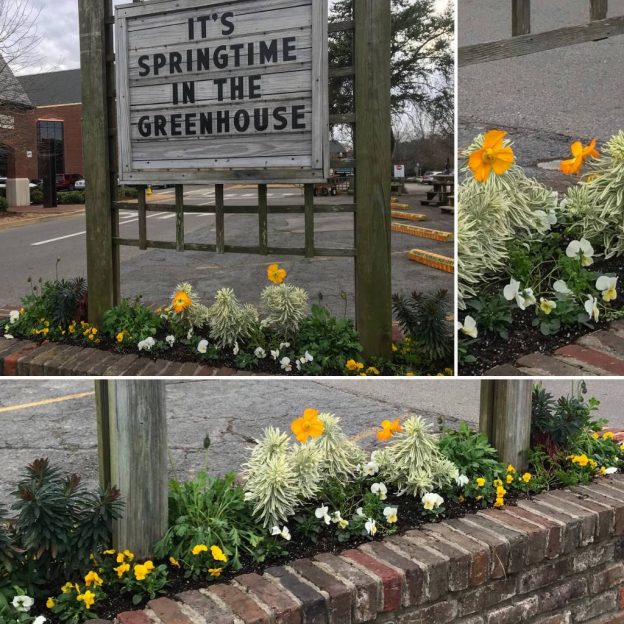


For all of you winter weary souls, February is approaching and spring won’t be far behind. Here’s a peek into the greenhouse to brighten your day…

 I’ll be honest, my hopes for a beautiful spring show in the ‘Better Late Than Never’ garden weren’t that great. Weather and time last fall seemed to conspire against me – no beautiful transplants of pansies, snapdragons, or foxgloves were put in the little plot across the street, even as everyone else was planning and planting their home gardens September through December. The summer garden went to seed and was finally pulled out with Ben’s help, in November.
I’ll be honest, my hopes for a beautiful spring show in the ‘Better Late Than Never’ garden weren’t that great. Weather and time last fall seemed to conspire against me – no beautiful transplants of pansies, snapdragons, or foxgloves were put in the little plot across the street, even as everyone else was planning and planting their home gardens September through December. The summer garden went to seed and was finally pulled out with Ben’s help, in November.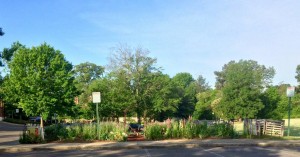
Sometimes, though, nature helps us along. Walking to my car at the end of early winter days I’d glance at the garden, its four beds seemingly lifeless plots of earth. If I had time I’d walk through, looking to see if any seedlings were emerging. There were, zinnias and sunflowers mostly, seeds dropped from fading blooms, germinating in the still warm soil. But I knew these were destined to freeze in the upcoming winter chill. Oh well, I thought, maybe I can get something in after the holidays.
 The weeks of late summer through fall had passed quickly. We held Molly’s wedding at the shop, and autumn plants and loads of pumpkins arrived and went. The days flew by during the frenetic holiday season that ended as suddenly as it started. January, and a new year, had arrived.
The weeks of late summer through fall had passed quickly. We held Molly’s wedding at the shop, and autumn plants and loads of pumpkins arrived and went. The days flew by during the frenetic holiday season that ended as suddenly as it started. January, and a new year, had arrived.
I finally had more time to concentrate on the little garden across the street with the apt name. I’d noticed, on the few December days I had a moment to look, that there were tiny bachelor button plants everywhere in 3 of the beds. I couldn’t do more than try to thin them out, though, with what little time I had.
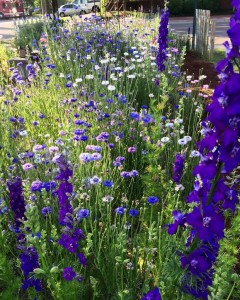 They’d bloomed in the garden the spring prior and had most definitely reseeded, but with barely any thinning were carpeting 3 of the beds quite thickly. I watched them fill in with some alarm. Would they smother themselves out because they were too close together? I decided to let well enough be and see what would happen.
They’d bloomed in the garden the spring prior and had most definitely reseeded, but with barely any thinning were carpeting 3 of the beds quite thickly. I watched them fill in with some alarm. Would they smother themselves out because they were too close together? I decided to let well enough be and see what would happen.
Spotting that bit of growth in the garden energized me. Even as the bachelor buttons were putting on their amazing growth spurt through January and February, I was tossing out seeds of larkspur in all shades.
I’d choose a few Botanical Interests seed packets off the rack, larkspur in shades of blue or mixes of blues, pinks, and whites. Eyeing the beds, I imagined perfect color combinations, letting the seed slip through my fingers onto the uneven soil.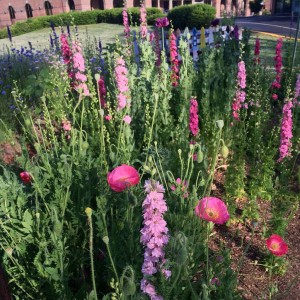
I scanned the garden each morning, hoping to see some spots of green. Impatient, I would scatter more seeds – packets of sweet alyssum, oriental poppies, mixed colors of larkspur – willing an abundance of flowers for spring.
 Finally I saw the ferny foliage of the larkspur here and there between the crowded bachelor buttons and the distinctive blue-green foliage of the oriental poppies appeared too.
Finally I saw the ferny foliage of the larkspur here and there between the crowded bachelor buttons and the distinctive blue-green foliage of the oriental poppies appeared too.
Each day as the plants grew, more and more people asked what was growing in the garden. I’d explain, smiling, about plants reseeding and seeds thrown onto the ground on cold winters days. Most people looked incredulous. From seed? Yes, I’d answer, seeds, and a prayer for spring.
By Kris Blevons
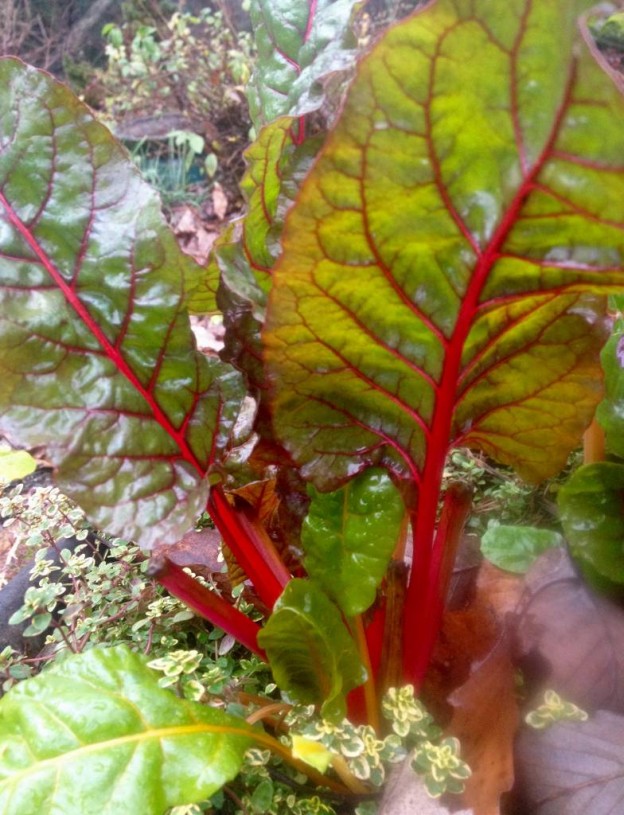
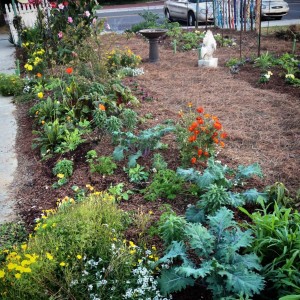
Tucking in winter plants around fall annuals, late fall…
The ‘better late than never garden’ is certainly living up to its name, since it was planted at the beginning of November 2014, and most of it finished just prior to the hectic holiday season, a full month later than I would have liked. This ‘better late than never’ schedule is working out okay so far, though, as the plants are growing steadily. Of course, more updates will follow, documenting successes and the inevitable failures that every garden and gardener has.
Most of these pictures were taken quickly very early on a mid-December morning in the middle of the holiday rush. Since there were other things that needed to be done, I couldn’t linger; but now, with the new year and more time, here’s an overview of the planting process and selection in this ‘better late than never’ winter garden.

Mid-December. Mulched and growing…
Let me admit right off that I’m not a “garden designer”. I can’t tell you that I drew a beautiful rendering of what I envisioned this garden to be come spring. No, the reality is that I grabbed a few packs of this and a few pots of that (usually in the middle of a busy day), raced across the street trowel and plants in hand, and plugged them in wherever I felt they worked best. So, in that way, little by little and over and over, the garden was planted. Time, attention, and the weather will determine how it turns out this spring.
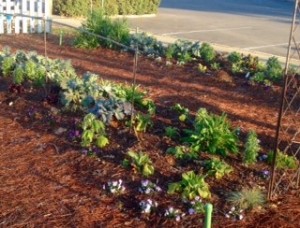
Violas, delphinium, poppies, kale, curly parsley, bachelor buttons and more growing… Mid-December
I began by planting a few foxglove, delphinium, and bachelor buttons under the still blooming summer tithonia. Then, when it was finally pulled out (Better late than never too!), pansies, violas, and sweet alyssum were added to large spaces that opened up.

Red Veined Sorrel, Rumex sanguinea, in the winter garden…January
Since the summer annuals were pulled out of them first, the two front beds were planted the earliest with snapdragons, poppies, bachelor buttons, chard, curly parsley, dill (The dill will eventually freeze at some point.), red veined sorrel, ‘Bull’s Blood‘ beets, kale, and mustard “Red Giant“. There’s quite a mix of annuals, herbs, flowers, and even bulbs (dwarf narcissus and ipheion) in each bed.
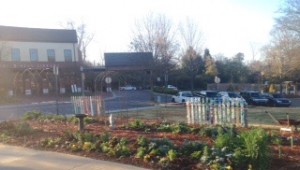
The ‘better late than never garden’ in mid-December…
A good layer of mulch is really important for your winter garden. Some folks start with a completely empty bed, add the mulch, then plant through it, a great method and easy to do. Of course, I did just the opposite. I had the time to plant before I had the help for the mulch! So, inevitably, there I was, mulching in the dark before the first cold snap of the season.
I also made sure everything was watered well before spreading the shredded pine bark around the little plants. There will be many more cold snaps before the winter is through, and I’m counting on this mulch to keep the soil warm since this isn’t a garden that gets babied.
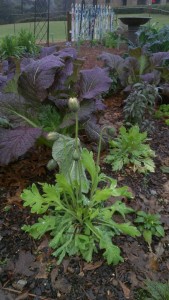
A poppy, in bud, with ‘Red Giant’ ornamental mustard in the ‘better late than never garden’ in January…
For people that don’t have big blocks of time (That’s most of us, I think.), planting a little bit at a time does work…obviously I’m a poster child for it. Now I’m concentrating on keeping winter weeds controlled in the beds, since the two worst offenders, chickweed and henbit, insist on coming up. Don’t let these winter weeds get hold in your garden. Pulling a few every week is far more preferable than tackling them come spring, after they’ve been allowed to smother your pansies and violas.
Have you planted some flowers for spring? If you haven’t, try a few poppies, pansies, or violas since, as you know now, it’s never too late to plant a garden. I’ll keep you posted on our ‘better late than never’ garden’s progress too!
This January our winter temperatures dropped lower than they’ve been in two decades. While uncomfortable, this is actually good for easing the summer bug population (Ticks, mosquitoes and fleas come to mind.). But it does put a damper on gardening efforts, though dormant trees, shrubs and perennials can still be planted and bright pansies added to planters and garden beds carry us into spring.
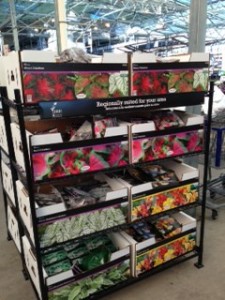 However, a friend recently sent a picture she took (mid January) of warm weather caladium bulbs that had been left outside on display racks for sale in freezing temperatures at one of the “big box” stores in town. Now, caladiums grown in pots are so heat loving we don’t even begin to carry them until late April – and advise people not to plant caladium bulbs in the ground until the soil is thoroughly warmed in May.
However, a friend recently sent a picture she took (mid January) of warm weather caladium bulbs that had been left outside on display racks for sale in freezing temperatures at one of the “big box” stores in town. Now, caladiums grown in pots are so heat loving we don’t even begin to carry them until late April – and advise people not to plant caladium bulbs in the ground until the soil is thoroughly warmed in May.
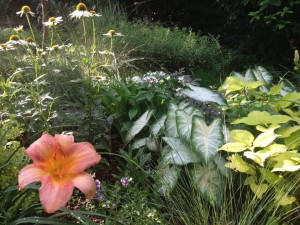
Caladiums in the summer garden – they love the heat…
Why should this matter to you? Because, if you weren’t aware of this, you or your neighbor might have bought these and, on the next warm, sunny day, planted them. Of course, after having been left outside on the racks in those temperatures, your gardening failure is guaranteed since the bulbs were not properly taken care of. It’s highly questionable whether they should even be for sale yet – unless they think someone will purchase them to start inside in pots and plant them outside at the proper time (May, remember?).
This is just one example of why shopping for your plants with people who sell only plants, at locally owned, independent garden shops, matters. Thanks for reading.
Some pictures from the greenhouse in winter…Rex begonias, agloenemas (Chinese evergreens), angel wing begonias, fronds of a neantha bella palm, variegated Algerian ivy, Sanseveria, plumosa ferns, aloe and succulents. Can you find them all?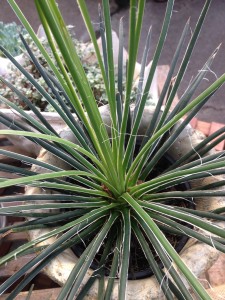
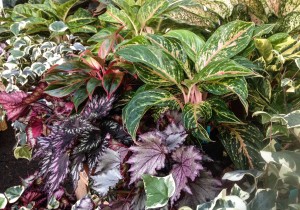
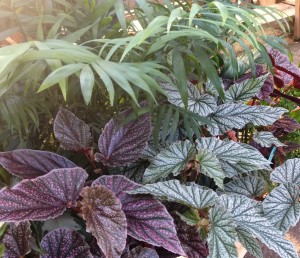
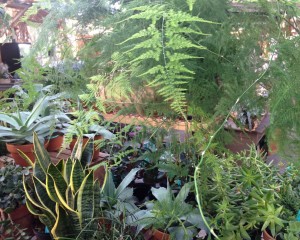
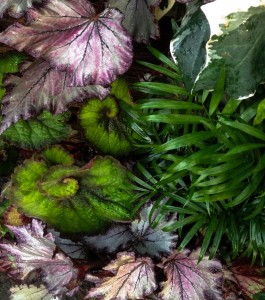

air plants have found a home in these colorful frames…
January in the greenhouse is a quiet time. Sure, there are folks coming in for a houseplant for a pot, or to pick up a few pansies to fill in their winter weary containers, but for the most part there’s plenty of time to work on projects of all sorts.
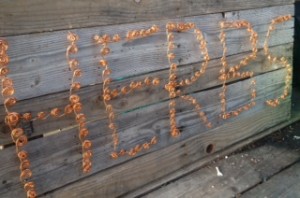
Molly created this herb sign with aluminum wire and old pallets…
This month, Jamie, Pinkie and Molly, with the help of Lauren, have been painting up a storm, and the stage area has taken on a new look. Molly is also working on signs for the outdoor nursery, while Bert and Ben are building new tables. it’s fun to change things up, and this is the time of year to do it!
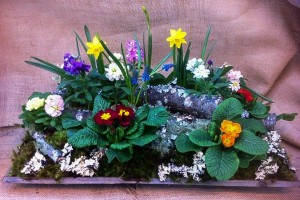
a spring garden using lichen covered branches and spring flowers…
Of course, arrangements take priority always, for customers who come in needing something for themselves, for a party or to give as a gift – and we enjoy this creative outlet too. Jamie brought in a lot of lichen covered branches, and has been using them beautifully as part of table top arrangements. They look wonderful mixed in with the bright primroses of winter, and the forced bulbs including narcissus, muscari, and soon, tulips and crocus.
Winter branches of pussy willow have been a staple too, and we’ve been adding them to orchid and foliage arrangements. Soon the greenhouse will be filled with even more houseplants of all sorts, and we’ll begin creating combinations of plantings that can be transferred outside when the temperatures warm, later in the spring.
January in the greenhouse is spent doing chores that must be done, but also on things that are just plain fun!
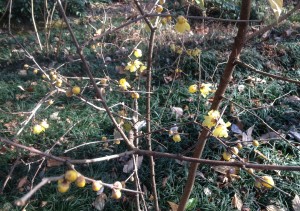
wintersweet…
The last couple of posts have taken a tour through my southern garden in the midst of winter. This is just one garden. The design possibilities of winter gardens in the south are as endless as there are plants to choose from and the creative (and physical) force to make it happen. On this walk, there are a few shrubs highlighted, a vine, an evergreen perennial, and some bulbs. So, here’s a little bit of everything to whet your appetite for spring and the long summer to follow. With the below normal temperatures we experienced earlier this month, some of these shrubs may not bloom as I’d expected…this is truly one of the perils of gardening in the south. It’s impossible to cover everything!

mountain laurel buds…
One shrub that I’ll need to cut back after it blooms this year is Chimonanthus praecox, or Wintersweet. It certainly lives up to its name, as its many pale, bell shaped, yellow flowers are indeed quite fragrant and bloom over a long period. The first day I catch a hint of Wintersweet on the air I know it’s the new year in the garden. Its fragrant blooms are followed by the even more heavily scented daphne odora next month. Fragrance each month of the year should be everyone’s goal in the garden!
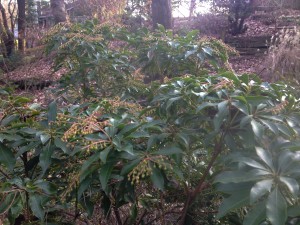
pieris…
For pretty flowers in late spring and glossy evergreen foliage, the mountain laurel, kalmia latifolia, can’t be beat. I’ve planted two small ones along a slope, hoping they’ll eventually create a tall evergreen thicket as a back drop to the spike winterhazel (corylopsis spicata ‘Ogon’) that’s planted in front of them.
My friend, and noted gardener, Weesie Smith, always said I must deadhead the blooms of the mountain laurel (and pieris too) to ensure blooms the next year. I do this faithfully…though it’s difficult with the pieris as there are so many! Both the mountain laurel and pieris are loaded with buds this year. The pieris will bloom first, with many, many tiny dangling white bell shaped flowers along its branches. How beautiful it is in the height of spring!

Disporopsis pernyi
Planted at the base of a large elm are some evergreen solomon’s seal, disporopsis pernyi. This evergreen, slowly spreading perennial groundcover is right at home in a woodland garden, offering white, bell shaped flowers along the stems in early spring. This clump makes a good green counterpoint to the variegated Solomon’s seal in the same area that dies back each winter. It is truly a beautiful addition to any garden.

Schizophragma…
A vine with a scary name, Schizophragma hydrangeoides ‘Moonlight’, is also quite beautiful…though January might not be it’s best month. Also known by it’s common name, climbing hydrangea, because its blooms resemble those of the hydrangea, it was planted at the base of a tree and now has reached almost to the top, at least 30′ in the air. Its blooms will cover the tree trunk in mid summer, reaching out and away from the trunk. Though it took a few years before it bloomed, it has bloomed now reliably each summer.
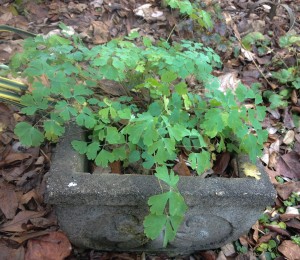
Aquilegia..
Closer to the house, up in the herb garden, a columbine has seeded itself in a small, concrete planter. This is aquilegia chrysantha, with light yellow blooms on long spurs in late spring. The original columbine, a gift from a friend, is long gone, but this one found a happy home and has been here for a few years now. The extra drainage offered by the planter is appreciated by this columbine. All I’ve had to do is clear fallen leaves from the crown of the plant. It hasn’t died back yet; though, with colder temperatures, it might.
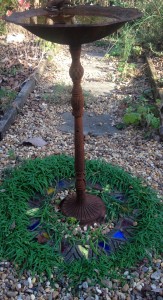
Ipheion…
The ipheion, a little bulb that has slowly been spreading in this area, is now showing it’s short, strappy bulb foliage. The soft blue blooms will appear in early summer, ringing the base of this birdbath. It’s been one of my favorite bulbs since it’s easy to grow and naturalizes so readily. And, even more importantly, the squirrels and chipmunks don’t seem to care for it!
As you can see, there’s more than meets the eye in the January garden, and, if you know where to look, the promise of an entire season to come!

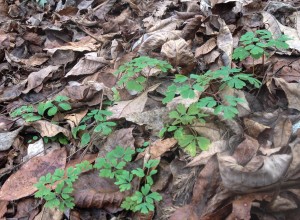
false rue anemone…

cyclamen hederifolium…
January is frigid in many parts of the country and can be a bleak month at best. But it’s also a good time to take a walk through your landscape, observing and planning. Here are some things I spotted on a short walk recently.

geranium ‘Biokovo’…
Native plants like false rue anemone, Enemion biturnatum, are beginning to show through the fallen leaves and promise pure white blooms this spring. Only the bloodroot is a purer white. The cyclamen hederifolium blooms are past, but the pretty mottled foliage is spreading. Here’s some under a native azalea. There are also crocus bulbs interplanted with these cyclamen that will be coming through the leaf litter soon.
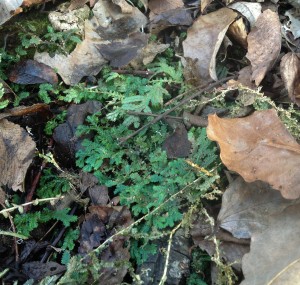
selaginella…
Perennial geraniums are good, tough plants too. Here the foliage of Geranium x cantabrigiense ‘Biokovo’, a cranesbill geranium, is looking quite happy along a rocky slope. It’s a pretty groundcover here and gets enough sun in this spot to bloom in the late spring. After the white flowers tinged with pink fade, I’ll clip it back to keep it tidy.

acorus variegata…
A little farther down the slope, and in more shade, is some selaginella uncinata, or peacock spikemoss. This groundcover is closely related to ferns and likes this shaded, moist spot. By midsummer, with enough moisture, it will be a lush, blue/green carpet underneath the trees and sheltered by the rock outcrop.
Below the rock outcrop, and along a dry riverbed, a spring provides water for evergreen acorus. In addition to Acorus ‘Ogon’, a yellow variegated form, here is the Acorus variegata, with a white variegation. Both of these love moisture, and they spread freely. In February these will get cut back at the same time the dwarf mondo is cut, making way for new, fresh growth.

holly ferns…
Other plants that will need old, tattered, winter damaged fronds cut off next month are the perennial ferns, including tassel (polystichum polyblepharum), autumn (Drypteris erythrosora), and, shown here, holly ferns (Cyrtomium falcatum). Sure, they’re evergreen, but, by winter’s end, they definitely need cleaning up. Wait until at least the end of February to do any drastic cutting back, though, as the old foliage also helps protect the crown of the plants from cold temperatures.
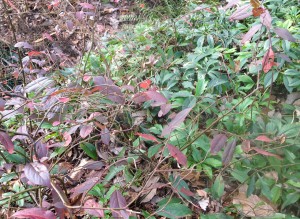 Above the water but spreading down the slope toward it, is a planting of Virginia sweetspire, Itea virginica ‘Henry’s Garnet’ , still holding the garnet colored fall foliage of its name. Underneath this spreading, suckering, shrub is another common evergreen perennial groundcover, the reliable Lenten roses, helleborus orientalis.
Above the water but spreading down the slope toward it, is a planting of Virginia sweetspire, Itea virginica ‘Henry’s Garnet’ , still holding the garnet colored fall foliage of its name. Underneath this spreading, suckering, shrub is another common evergreen perennial groundcover, the reliable Lenten roses, helleborus orientalis.
These two have gradually spread over the years, and the itea will also show off it’s dainty fragrant white blooms along arching stems this spring. It is truly an all season shrub, and the long lasting lenten roses blooming under them are good companions. Soon enough it will be time to clip off old, winter damaged leaves of the lenten roses, but not yet. January is the month to simply observe, taking time to enjoy a quiet walk through the garden on a sunny, chilly day.

This cheerful basket arrangement contains flowers available in January and February.
This pretty winter basket was a gift delivered to one of our customers on a dreary day in January. We hope it made them smile!
The happy flowers in this arrangement include tete a tete narcissus, cyclamen, primroses and blue campanula, blooming plants that are readily available in January and February.
Come in and put your own arrangement together or take a pot of primrose to a neighbor and make them smile too!